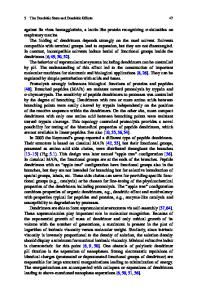Recording Dendritic Ion Channel Properties and Function from Cortical Neurons
Dendrites emerging from the cell bodies of neurons receive the majority of synaptic inputs. They possess a plethora of ion channels that are essential for the processing of these synaptic signals. To fully understand how dendritic ion channels influence n
- PDF / 255,575 Bytes
- 7 Pages / 504.57 x 720 pts Page_size
- 87 Downloads / 285 Views
1
Introduction Dendrites are extensive processes emerging from the cell body of neurons. They cover a vast surface area and receive most of the synaptic inputs impinging onto neurons. Dendrites also possess a large variety of ligand-gated and voltage-gated ion channels (1, 2). Often, the density and characteristics of these dendritic ion channels differ from those present at the soma. These ion channels play an important role in determining the shape and integration of synaptic inputs (1–3). To fully understand synaptic signal processing, it is critical and essential to evaluate their properties and function. There are a number of methods including immunohistochemistry and imaging that would provide valuable information on the location and potential function of dendritic ion channels. Perhaps the most direct method, though, for assessing dendritic ion channel biophysical properties and their effects on dendritic activity is electrophysiological recording (4). The advent of the patch-clamp technique together with advances in microscopy has made it possible to make electrophysiological recordings under visual guidance from the dendrites of many neurons such as hippocampal and
Nikita Gamper (ed.), Ion Channels: Methods and Protocols, Methods in Molecular Biology, vol. 998, DOI 10.1007/978-1-62703-351-0_24, © Springer Science+Business Media, LLC 2013
303
304
Mala M. Shah
cortical pyramidal cells in the acute brain slice preparation. The most common approach, which I will describe in this chapter, involves the use of infrared differential interference contrast (IR-DIC) optics. This generally allows dendrites that are greater than 1 μm in diameter to be patched. Newer techniques involving the use of confocal and two-photon laser microscopy to patch smaller diameter dendrites such as basal dendrites are also being developed (5). The ability to patch dendrites has resulted in considerable new and interesting information about the contribution of dendritic ion channels to neuronal cell excitability as well as neural network activity.
2
Materials Prepare all solutions using deionized 18 MΩ water at room temperature and store at 4°C (unless otherwise indicated). All waste materials should be disposed of according to local institutional waste disposal regulations.
2.1
Solutions
1. Cutting solution: 110 mM choline chloride, 2.5 mM KCl, 1.25 mM NaH2PO4, 25 mM NaHCO3, 0.5 mM CaCl2, 7 mM MgCl2, and 10 mM dextrose; bubbled with 95%O2/5% CO2 to obtain pH of 7.2; ~290 mOsm (see Note 1). 2. External solution: 125 mM NaCl, 2.5 mM KCl, 1.25 mM NaH2PO4, 25 mM NaHCO3, 2 mM CaCl2, 2 mM MgCl2, 10 mM dextrose; bubbled with 95% O2/5% CO2 to obtain pH 7.2; ~300 mOsm (see Note 2). 3. Standard internal recording solution for whole-cell recordings: 120 mM KMeSO4, 20 mM KCl, 10 mM HEPES, 2 mM MgCl2, 0.2 mM EGTA, 4 mM Na2-ATP, 0.3 mM Tris-GTP, 14 Tris-phosphocreatine; pH was adjusted to 7.3 with KOH; ~310 mOsm (see Note 3). 4. Cell-attached recording solution (mM): 140 KCl, 10 HEPES, 1 MgCl2, 2 CaCl2; pH adjusted to 7.3 (see Note 4).
2
Data Loading...











